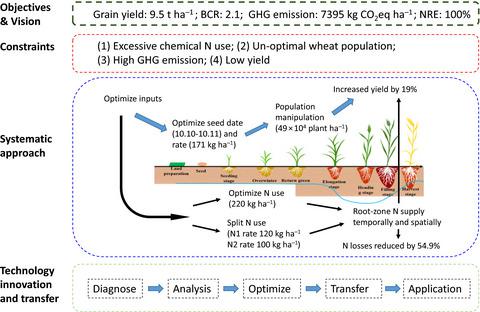当前位置:
X-MOL 学术
›
Food Energy Secur.
›
论文详情
Our official English website, www.x-mol.net, welcomes your
feedback! (Note: you will need to create a separate account there.)
Optimizing wheat production and reducing environmental impacts through scientist–farmer engagement: Lessons from the North China Plain
Food and Energy Security ( IF 4.0 ) Pub Date : 2020-11-04 , DOI: 10.1002/fes3.255 Wei Jiang 1 , Annah Zhu 2 , Chong Wang 1 , Fusuo Zhang 1 , Xiaoqiang Jiao 1
Food and Energy Security ( IF 4.0 ) Pub Date : 2020-11-04 , DOI: 10.1002/fes3.255 Wei Jiang 1 , Annah Zhu 2 , Chong Wang 1 , Fusuo Zhang 1 , Xiaoqiang Jiao 1
Affiliation

|
Producing high economic benefits and high grain yields with limited environmental impacts is crucial for feeding the world's growing population. Yet it remains challenging to improve the performance of one objective without creating unintended consequences for other objectives. This is especially difficult for smallholders navigating a diverse array of environmental and personal demands. This study demonstrates how combining participatory research through the Science and Technology Backyards (STB) approach with Pareto‐based ranking modeling can increase smallholder production while also reducing environmental impact. Through an intensive farmer survey in a 1 × 1 km grid in Quzhou County, we demonstrate that farmers engaged in STBs performed better according to multiple objectives (i.e., optimizing overall grain yield, benefit‐cost ratio, and GHG emissions, without compromising any one of these objectives) than farmer's not engaged in STBs. Moreover, we used a Pareto optimization approach (OPT) to determine the optimal smallholder scenario. We found that under OPT, grain yield could reach 9.5 t/ha, with a benefit‐cost ratio of 2.1, a 100% N recovery efficiency, and 7,395 kg CO2eq ha−1 GHG emissions. With OPT as a final goal, our research team worked with STB farmers to improve economic and environmental outcomes without compromising yield. Our findings demonstrate that no significant difference was obtained between farmers engaged in STBs and these under OPT. Compared with non‐STB farmers, STB farmers’ grain yield improved by 18%, benefit‐cost ratio improved by 26% due to improved N recovery efficiency, and GHG emissions were reduced by 31%. These improvements demonstrate the power of scientist–farmer engagement for optimizing wheat production. Such engagement allows farmers to modify their agronomic practices to more closely match Pareto optimal conditions, thus improving environmental and economic benefits without compromising yield. Our results provide solid evidence of the potential for sustainable wheat production by combining modeling with participatory research.
中文翻译:

通过科学家与农民的合作优化小麦生产并减少环境影响:华北平原的经验教训
在对环境影响有限的情况下产生高经济效益和高粮食产量对于养活世界不断增长的人口至关重要。然而,提高一个目标的绩效而不会对其他目标造成意想不到的后果仍然具有挑战性。对于满足各种环境和个人需求的小农来说,这尤其困难。本研究展示了如何将科学技术后院 (STB) 方法的参与式研究与基于帕累托的排名模型相结合,从而提高小农生产,同时减少对环境的影响。通过对曲周县 1 × 1 公里网格的深入农民调查,我们证明从事机顶盒的农民在多个目标(即优化粮食总产量、效益成本比和温室气体排放,而不损害任何一个目标)下表现更好。这些目标)比没有从事 STB 的农民要高。此外,我们使用帕累托优化方法(OPT)来确定最佳小农场景。我们发现,OPT下粮食产量可达9.5吨/公顷,效益成本比为2.1,氮肥回收效率为100%,温室气体排放量为7,395 kg CO 2 eq ha −1 。以 OPT 作为最终目标,我们的研究团队与 STB 农民合作,在不影响产量的情况下改善经济和环境成果。我们的研究结果表明,从事 STB 的农民和接受 OPT 的农民之间没有显着差异。与非STB农户相比,STB农户的粮食产量提高了18%,氮肥回收效率提高,效益成本比提高了26%,温室气体排放量减少了31%。 这些改进证明了科学家和农民参与优化小麦生产的力量。这种参与使农民能够修改他们的农艺实践,以更接近帕累托最优条件,从而在不影响产量的情况下提高环境和经济效益。我们的结果通过将建模与参与性研究相结合,为可持续小麦生产的潜力提供了坚实的证据。
更新日期:2020-11-04
中文翻译:

通过科学家与农民的合作优化小麦生产并减少环境影响:华北平原的经验教训
在对环境影响有限的情况下产生高经济效益和高粮食产量对于养活世界不断增长的人口至关重要。然而,提高一个目标的绩效而不会对其他目标造成意想不到的后果仍然具有挑战性。对于满足各种环境和个人需求的小农来说,这尤其困难。本研究展示了如何将科学技术后院 (STB) 方法的参与式研究与基于帕累托的排名模型相结合,从而提高小农生产,同时减少对环境的影响。通过对曲周县 1 × 1 公里网格的深入农民调查,我们证明从事机顶盒的农民在多个目标(即优化粮食总产量、效益成本比和温室气体排放,而不损害任何一个目标)下表现更好。这些目标)比没有从事 STB 的农民要高。此外,我们使用帕累托优化方法(OPT)来确定最佳小农场景。我们发现,OPT下粮食产量可达9.5吨/公顷,效益成本比为2.1,氮肥回收效率为100%,温室气体排放量为7,395 kg CO 2 eq ha −1 。以 OPT 作为最终目标,我们的研究团队与 STB 农民合作,在不影响产量的情况下改善经济和环境成果。我们的研究结果表明,从事 STB 的农民和接受 OPT 的农民之间没有显着差异。与非STB农户相比,STB农户的粮食产量提高了18%,氮肥回收效率提高,效益成本比提高了26%,温室气体排放量减少了31%。 这些改进证明了科学家和农民参与优化小麦生产的力量。这种参与使农民能够修改他们的农艺实践,以更接近帕累托最优条件,从而在不影响产量的情况下提高环境和经济效益。我们的结果通过将建模与参与性研究相结合,为可持续小麦生产的潜力提供了坚实的证据。











































 京公网安备 11010802027423号
京公网安备 11010802027423号